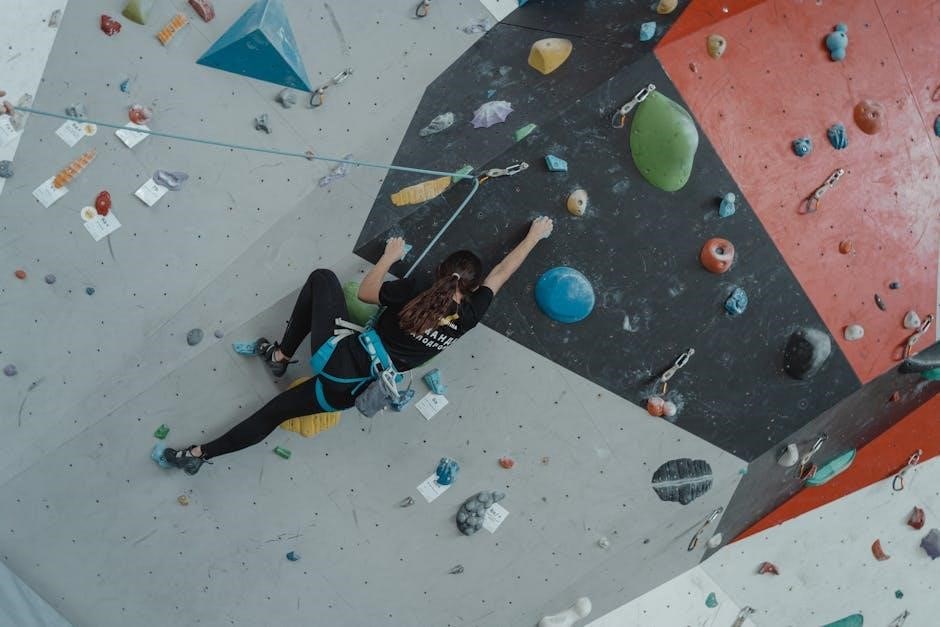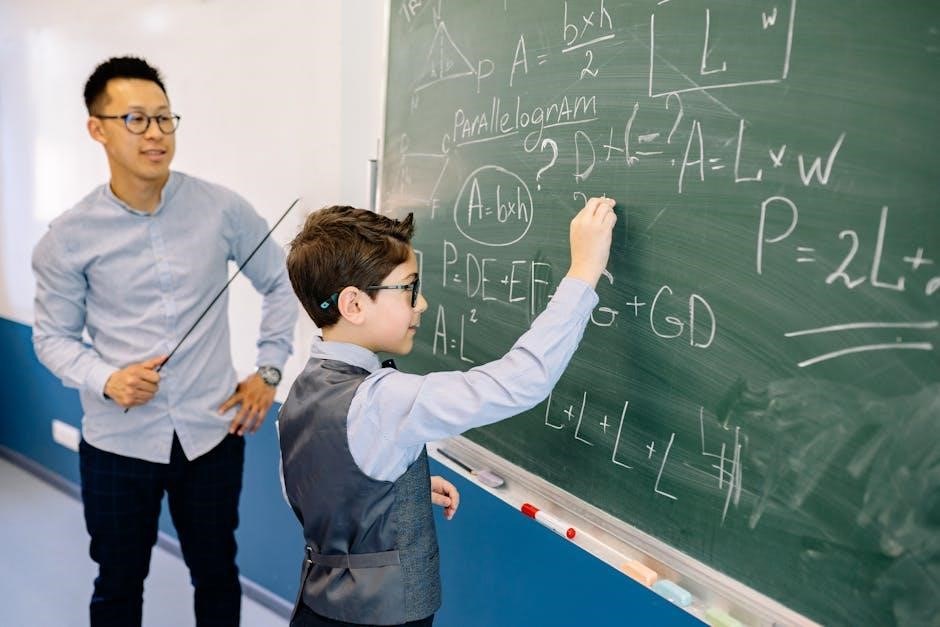high impact instructional strategies

High impact instructional strategies are evidence-based methods that significantly enhance student learning and achievement, focusing on effective teaching practices and research-backed approaches to maximize educational outcomes․
1․1 Definition and Importance of High Impact Instructional Strategies
High impact instructional strategies are evidence-based teaching methods proven to significantly improve student learning outcomes․ They are deliberately chosen to address diverse student needs, ensuring equity and engagement․ Researchers like John Hattie have identified these strategies as critical for bridging learning gaps and fostering academic success․ By focusing on practices like formative assessments and explicit instruction, teachers can enhance clarity, deepen understanding, and promote meaningful student progress․ These strategies are essential for creating a supportive and effective learning environment that maximizes student potential․
1․2 Brief Overview of Key Strategies
Key high impact strategies include formative assessments, explicit instruction, scaffolding, feedback, and metacognitive techniques․ These methods are designed to actively engage students, clarify expectations, and build resilience․ Formative assessments allow teachers to monitor progress, while explicit instruction ensures clear delivery of content․ Scaffolding supports students during challenging tasks, and feedback provides guidance for improvement․ Metacognitive strategies empower students to reflect on their learning, fostering independence and self-awareness․ Together, these approaches create a structured yet adaptable framework that addresses diverse learning needs and enhances overall academic performance․

Key High Impact Instructional Strategies
Key high impact instructional strategies include evidence-based approaches like formative assessments, explicit instruction, scaffolding, and metacognitive techniques, proven to enhance student learning and academic success effectively․
2․1 Formative Assessments
Formative assessments are informal, ongoing evaluations used to monitor student progress during instruction․ They involve strategies like quizzes, class discussions, and observations to gauge understanding․ Teachers use this feedback to adjust teaching methods and address learning gaps promptly․ Formative assessments help identify misconceptions early, allowing for timely interventions․ They also encourage active participation and engagement, fostering a growth mindset among students․ By integrating these assessments, educators can personalize learning experiences and ensure students stay on track to meet academic goals effectively․
2․2 Explicit Instruction
Explicit instruction is a structured teaching method that delivers clear, step-by-step explanations of concepts․ Teachers demonstrate skills, break tasks into manageable parts, and provide guided practice․ This approach ensures students understand expectations and build foundational skills․ It is particularly effective for introducing new or complex material, as it minimizes confusion and promotes mastery․ Explicit instruction also includes modeling, think-aloud strategies, and opportunities for practice, making it a cornerstone of high-impact teaching that supports all learners, especially those needing additional support․
2․3 Scaffolding Techniques
Scaffolding techniques involve providing temporary, guided support to students as they learn new skills or concepts․ Teachers gradually release responsibility to students as they demonstrate readiness․ This approach ensures students are not overwhelmed and builds confidence․ Strategies include modeling tasks, using visual aids, and offering prompts or cues․ Scaffolding is particularly effective for differentiation, as it allows teachers to meet students at their individual learning levels․ By breaking tasks into smaller steps, scaffolding fosters independence and deep understanding, making it a powerful tool in high-impact instruction․
2․4 Feedback and Questioning
Feedback and questioning are essential for guiding student learning and promoting critical thinking․ Effective feedback is specific, timely, and actionable, helping students understand their progress and areas for improvement․ Questioning strategies, such as open-ended or Socratic questions, encourage deeper engagement and reflection․ Teachers can also use think-pair-share or wait-time techniques to ensure all students participate․ By integrating feedback and questioning, educators create a dynamic learning environment that fosters collaboration, clarifies misconceptions, and enhances overall academic performance․ These strategies are integral to high-impact instruction, driving student growth and understanding․
2․5 Metacognitive Strategies
Metacognitive strategies empower students to regulate their own learning by thinking about their thinking․ Techniques like self-questioning, reflective journaling, and self-assessment help students plan, monitor, and evaluate their learning processes․ Teachers can model metacognition by verbalizing their problem-solving steps or encouraging students to set learning goals․ These strategies enhance problem-solving skills, critical thinking, and self-awareness, fostering independent learners․ By integrating metacognitive practices, educators help students develop a deeper understanding of how they learn best, promoting academic resilience and lifelong learning abilities․

The Role of the Teacher in Implementing High Impact Strategies
Teachers are central to effectively implementing high-impact strategies, requiring clarity, precision, and strong student-teacher relationships to guide learners toward their full potential․
3․1 Teacher Clarity and Precision
Teacher clarity and precision are foundational for effective instruction, ensuring students understand learning goals, expectations, and success criteria․ Clear communication involves using specific examples, unambiguous language, and structured lessons to minimize confusion․ Teachers should explicitly state objectives, provide exemplars, and break tasks into manageable steps․ This clarity enhances student focus and reduces misunderstandings, fostering a more productive learning environment․ By prioritizing precision, educators ensure that all students, regardless of background, can access and engage with the content, leading to improved academic outcomes and increased confidence․
3․2 Student-Teacher Relationships
Strong student-teacher relationships are critical for fostering academic success and emotional well-being․ Positive interactions, open communication, and empathy create a supportive learning environment․ Teachers who take a genuine interest in students’ lives build trust and motivation․ Clear expectations and consistent encouragement help students feel safe and valued․ When relationships are nurtured, students are more likely to engage actively, take risks, and persist through challenges․ These connections also support social-emotional development, fostering resilience and a growth mindset that extends beyond the classroom․
3․3 Professional Development for Teachers
Professional development for teachers is essential for implementing high impact instructional strategies effectively․ Ongoing training, workshops, and collaborative learning opportunities help educators stay updated on best practices․ This fosters innovation, enhances teaching skills, and ensures alignment with curriculum goals․ Professional development also encourages a growth mindset among teachers, enabling them to adapt to changing educational needs and technologies․ By investing in teacher growth, schools create a supportive environment that ultimately benefits student learning and academic success․ Continuous improvement ensures educators remain equipped to deliver high-quality instruction․

Technology Integration in High Impact Instruction
Technology integration enhances learning through interactive tools, fostering engagement, accessibility, and collaboration, while supporting innovative and personalized teaching methods effectively․
4․1 Blended Learning Approaches
Blended learning combines traditional face-to-face instruction with digital tools, offering flexibility and personalized learning experiences․ It integrates online resources, such as videos, interactive simulations, and collaborative platforms, with classroom activities․ This approach enhances student engagement, allows for self-paced learning, and provides immediate feedback․ Teachers can tailor instruction to meet diverse needs, fostering deeper understanding and improved academic outcomes․ Effective implementation requires intentional design, ensuring seamless integration of technology to support, rather than replace, meaningful teacher-student interactions and peer collaboration․
4․2 Educational Software and Tools
Educational software and tools are integral to modern teaching, enhancing engagement and efficiency․ Platforms like Kahoot! and Duolingo offer interactive, personalized learning experiences, while tools such as Google Classroom streamline content delivery and collaboration․ These resources provide real-time feedback, enabling teachers to track progress and tailor instruction․ They also support diverse learning styles, fostering inclusivity and accessibility․ By integrating these tools, educators can create dynamic, tech-rich environments that cater to individual needs, promoting deeper understanding and improved academic performance across all student groups․
4․3 Online Resources for Teaching
Online resources for teaching provide educators with accessible tools to enhance instruction․ Websites like Khan Academy, Teachers Pay Teachers, and Coursera offer a wealth of materials, from lesson plans to interactive content․ These platforms support diverse learning needs and allow teachers to supplement their curriculum with high-quality resources․ They also promote professional growth by offering courses and workshops․ By leveraging these resources, educators can create engaging, relevant, and effective learning experiences tailored to their students’ needs, fostering academic success and lifelong learning skills․

Cultural and Linguistic Responsiveness
Cultural and linguistic responsiveness is crucial for creating inclusive classrooms․ It involves understanding students’ diverse backgrounds to tailor instruction, ensuring equitable access to learning and fostering meaningful engagement․
5․1 Culturally Responsive Teaching
Culturally responsive teaching is an essential high-impact strategy that acknowledges and values students’ diverse cultural backgrounds․ It involves integrating students’ identities, experiences, and perspectives into the curriculum to create a supportive learning environment․ Teachers use culturally relevant materials, promote inclusivity, and foster connections between students’ lives and academic content․ This approach enhances engagement, builds trust, and ensures all students feel valued․ By being culturally responsive, educators address systemic inequities, promote social justice, and empower students to succeed academically and socially․
5․2 Supporting English Language Learners
Supporting English Language Learners (ELLs) involves tailored strategies to ensure their linguistic and academic success․ Teachers use visual aids, scaffolding techniques, and graphic organizers to simplify complex concepts․ Providing sentence stems and language frames helps ELLs develop academic vocabulary․ Differentiated instruction, such as tiered assignments, caters to varying proficiency levels․ Opportunities for peer interaction and structured discussions build confidence․ Incorporating ELLs’ cultural and linguistic backgrounds into lessons fosters engagement and relevance․ These practices promote equitable access to content, enabling ELLs to thrive academically and linguistically while connecting with their diverse experiences․
5․3 Inclusivity in the Classroom
Inclusivity in the classroom ensures all students feel valued and supported, regardless of race, culture, gender, or ability․ Teachers create respectful environments by promoting diversity in materials and discussions․ Differentiated instruction and culturally responsive practices help meet diverse needs․ Encouraging student voice and representation fosters a sense of belonging․ Inclusive practices also involve equitable access to resources and opportunities, ensuring no student is marginalized․ By addressing implicit biases and fostering empathy, teachers create spaces where all learners thrive, contributing to a positive and equitable educational experience․

Assessment and Data-Driven Instruction
Assessment and data-driven instruction guide teaching decisions, ensuring alignment with student needs․ Formative and summative assessments provide insights, enabling teachers to adjust strategies and improve outcomes effectively․
6․1 Summative Assessments
Summative assessments evaluate student learning at the end of an instructional period, providing a comprehensive measure of achievement․ These high-stakes assessments, such as final exams or standardized tests, determine whether learners have met specific goals․ They help teachers gauge the effectiveness of instruction and identify areas for improvement․ By analyzing summative data, educators can make informed decisions about future lessons and interventions․ These assessments also hold students accountable for mastering essential skills and concepts, ensuring readiness for subsequent academic challenges․
6․2 Using Data to Inform Teaching
Data-driven instruction involves analyzing assessment results to refine teaching practices and improve student outcomes․ By interpreting formative and summative data, educators identify learning gaps and adjust strategies to meet student needs․ This approach ensures instruction is targeted and effective, fostering academic growth․ Teachers can modify lesson plans, differentiate instruction, and provide targeted support․ Regular data analysis promotes a cycle of continuous improvement, enhancing both teaching quality and student achievement․ It ensures resources are used efficiently and helps maintain high standards of education․
6․3 Progress Monitoring
Progress monitoring involves regularly tracking student learning to ensure they are meeting academic goals․ This process helps teachers identify areas where students may need additional support or challenges․ By collecting and analyzing data over time, educators can adjust instruction to better align with student needs․ Progress monitoring also fosters collaboration between teachers, students, and parents, ensuring everyone is aligned in supporting student growth․ It provides insights into the effectiveness of interventions and helps celebrate milestones, promoting a growth-oriented classroom environment․

Student Engagement and Motivation
Student engagement and motivation are critical for learning․ Teachers can foster this through active participation, meaningful interactions, and creating a supportive classroom environment that values student contributions․
7․1 Strategies to Increase Student Engagement
Engaging students involves interactive activities, real-world connections, and choice boards․ Teachers can incorporate collaborative tasks, think-pair-share, and hands-on experiments to stimulate curiosity․ Using technology like polls and simulations enhances participation․ Recognizing student achievements and fostering a growth mindset also boosts engagement․ Providing opportunities for reflection and self-directed learning empowers students to take ownership of their education․ These strategies create an inclusive and dynamic classroom environment, ensuring students are motivated and actively involved in the learning process․
7․2 Building Intrinsic Motivation
Building intrinsic motivation focuses on fostering students’ internal drive to learn․ Teachers can promote curiosity and self-belief by providing autonomy, such as choice boards or self-paced tasks․ Encouraging mastery through clear goals and celebrating progress enhances self-efficacy․ Connecting learning to real-life purposes and student interests increases relevance․ Creating a supportive environment where risks are encouraged also nurtures motivation․ Reflective practices, like self-assessment, help students recognize their growth․ These strategies empower students to value learning for personal fulfillment rather than external rewards․

7․3 Gamification in Education
Gamification in education involves integrating game design elements into learning environments to enhance engagement․ Techniques like points, badges, and leaderboards motivate students by creating a sense of achievement․ Interactive activities, such as puzzles or quizzes, make learning fun and dynamic․ Gamification fosters healthy competition and teamwork, encouraging active participation․ When aligned with learning objectives, it boosts retention and problem-solving skills․ This approach caters to diverse learners, making complex concepts accessible and enjoyable․ By leveraging technology, educators can create immersive experiences that captivate students and promote deeper understanding․

Collaborative Learning Strategies
Collaborative learning strategies foster active engagement through group work, peer interaction, and shared problem-solving․ These approaches enhance communication, critical thinking, and teamwork skills among students․
- Encourages diverse perspectives and mutual support․
- Prepares students for real-world collaboration․
- Boosts accountability and collective achievement․
8․1 Cooperative Learning

Cooperative learning is a structured approach where students work in small, diverse groups to achieve shared learning goals․ It emphasizes positive interdependence, individual accountability, and social interaction․
- Groups are typically heterogeneous to promote peer teaching and collaboration․
- Students assume roles like leader, recorder, or reflector to ensure active participation․
- Teachers use strategies like jigsaw or think-pair-share to facilitate engagement․
- Encourages social skills, mutual respect, and a sense of community․
8․2 Peer Instruction and Tutoring
Peer instruction and tutoring involve students teaching and learning from one another, fostering deeper understanding and retention․ This strategy encourages active participation and collaboration, bridging gaps in knowledge and skills․ Reciprocal teaching, where students take turns explaining concepts, enhances communication skills․ Cross-age tutoring pairs older students with younger ones, promoting mentorship and confidence․ Teachers must train students to provide clear explanations and feedback․ This approach strengthens classroom relationships and creates a supportive learning environment, ensuring all students feel valued and engaged․ It also develops empathy and leadership skills among participants․
8․3 Group Work and Teamwork
Group work and teamwork are powerful strategies that foster collaboration, problem-solving, and shared accountability․ By dividing tasks and responsibilities, students learn to rely on one another’s strengths, promoting diverse perspectives․ Teachers should establish clear roles and expectations to ensure equitable participation․ Collaborative projects enhance critical thinking and communication skills․ Technology tools, such as shared documents and digital platforms, facilitate teamwork․ Group work also cultivates soft skills like leadership, adaptability, and conflict resolution, preparing students for real-world scenarios․ Regular feedback and reflection help refine teamwork dynamics and outcomes․ This approach strengthens social bonds and academic engagement․ It encourages active learning and mutual support․ Effective group work strategies maximize student potential and foster a collaborative classroom culture․ By teaching students to work together, educators prepare them for lifelong success in team-based environments․ Group work and teamwork are essential for developing well-rounded, socially adept learners․ They create opportunities for peer-to-peer learning and collective growth․ Implementing structured group activities ensures that all students contribute meaningfully․ This strategy bridges individual and collective learning, enhancing overall academic performance․ It also helps students develop empathy and understanding of different viewpoints․ Group work and teamwork are integral to creating an inclusive and effective learning environment․ They empower students to take ownership of their learning and work collaboratively toward common goals․ This approach not only improves academic outcomes but also nurtures essential life skills․ Teachers play a crucial role in guiding group dynamics and ensuring productive interactions․ By fostering a culture of collaboration, educators can unlock the full potential of group work and teamwork in the classroom․
Differentiated Instruction
Differentiated instruction tailors teaching methods to meet diverse student needs, ensuring engagement and academic success through customized content, processes, and products․
9․1 Understanding Differentiated Instruction
Differentiated instruction is a teaching approach that recognizes and responds to the diverse learning needs of students․ It ensures all learners can access the curriculum by adapting content, process, and product to suit individual abilities and interests․ This approach promotes equity and inclusion, allowing teachers to address varying learning styles, readiness levels, and cultural backgrounds․ By tailoring instruction, educators create a supportive environment where every student can achieve academic success․ Differentiated instruction requires intentional planning and flexibility to meet the unique needs of each learner․
9․2 Tiered Assignments and Learning Centers
Tiered assignments involve structuring tasks at varying levels of complexity to cater to different learning abilities․ This approach ensures students engage with content that challenges them appropriately․ Learning centers, on the other hand, provide hands-on, activity-based experiences that promote active learning․ These strategies allow teachers to address diverse learning needs, fostering a personalized and engaging classroom environment․ By incorporating tiered assignments and learning centers, educators can enhance student participation and understanding, ensuring all learners have opportunities to succeed․ These methods are integral to differentiated instruction․
9․3 Personalized Learning Plans
Personalized Learning Plans (PLPs) are tailored to individual student needs, ensuring learning is relevant and engaging․ These plans are developed collaboratively with students, parents, and teachers, setting specific goals and strategies․ PLPs foster independence by allowing students to take ownership of their learning․ They also enable teachers to track progress and adjust instruction to meet evolving needs․ By personalizing education, PLPs increase motivation and ensure students are well-prepared for future challenges, making them a powerful tool in high-impact instructional strategies․
High-impact instructional strategies are essential for effective education, fostering engagement, understanding, and growth․ By adapting to student needs, these approaches ensure meaningful learning experiences and future success․
10․1 Summary of High Impact Strategies
High-impact instructional strategies are research-backed methods that enhance learning outcomes by making instruction more intentional, engaging, and student-centered․ They include formative assessments, explicit instruction, scaffolding, feedback, metacognition, and technology integration, ensuring alignment with diverse student needs․ These approaches emphasize cultural responsiveness, inclusivity, and differentiated instruction, fostering critical thinking and creativity․ By prioritizing teacher clarity and precision, these strategies create structured yet adaptive learning environments, ultimately preparing students for success in an ever-evolving world․
10․2 The Future of Instructional Strategies
The future of instructional strategies will likely involve increased integration of technology, such as AI and AR, to create personalized learning experiences․ Competency-based education will emphasize mastery over traditional grading systems․ Teachers will need ongoing professional development to adapt to these changes․ Additionally, there will be a focus on culturally responsive practices and real-world applications to prepare students for future challenges․

